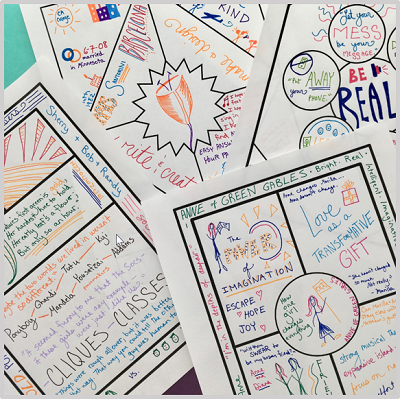

BLOGS > AUGUST 4, 2021
BY BETSY POTASH

But are one-pagers really all about art? At its core, a one-pager (originally developed as a classroom tool by AVID) is a no-fluff, just-the-good-stuff version of a set of information. In the business world, a boss might ask an employee to create a one-pager of six months of research so the boss can catch up. In English class, a teacher might ask a student to create a one-pager out of an entire novel, pulling the most important information and ideas from its pages and sharing it through words and images. Either way, it’s about finding the core of what’s worth taking away from something.
One-pagers can seem like the best or the worst pedagogic tool available, depending on what example you happen to be looking at. We tend to see the upper reaches of the example mountain on Instagram. But can one-pagers be useful even if your students aren’t planning their tours of Rhode Island School of Design (RISD)?
It turns out they can.
To find success with one-pagers, just follow three simple steps.
While you’re sure to get some interesting one-pagers if you ask students to simply condense what’s important about a text or unit into one page of information and images, you’re also going to get some terrible ones. It helps students succeed with one-pagers if you lay out exactly what you want included.
For example, for a one-pager on a novel, you might bullet the following elements:
You can tailor these expectations to any type of information, whether you’re asking for a one-pager on a novel, poem, short story, film, or podcast. You can even use one-pagers as a tool to learn more about students, having them create one-pagers about themselves, their reading histories or their families.

Creating a short rubric that shows how hitting the important elements thoughtfully leads to a strong grade on the assignment. This will help take away the anxiety from students who are uncomfortable with art. It will also make it a lot easier for you to quickly grade your one-pagers and get them up into a display on your classroom wall.

Even with a list of elements to include and a rubric, many students (especially those who hate art), will feel nervous around one-pagers at first. That’s where templates come in. Simply create a page divided into shaped sections and attach each necessary element to a section. It’s amazing how much it helps students relax into the assignment if instead of asking them to include two themes, you ask them to include two themes in the upper left hand rectangle. Simple, but highly effective.
Of course, some students will prefer artistic freedom. Simply differentiate by offering the template as an option, and let students choose. You’ll get creative work through both formats.
Once you get going with one-pagers, you’ll quickly see how versatile they are and how much the combination of imagery and ideas makes information memorable to your students.

Be sure to save time (once the one-pagers are created) for a gallery walk or mini-presentations to a partner or small group. Let your students see each other’s one-pagers so they continue to expand their ideas of what one-pagers can be like so they’re ready for further depth and innovation the next time you assign one.
|

BETSY POTASH
Betsy’s passion is helping English teachers build innovative and creative lessons. Get inspired and follow along with her at
An Author Interview with Drew Daywalt
June 27, 2025
Drew Daywalt, award-winning author of the best-selling The Day the Crayons Quit series, is about to release his second middle grade book with illustrator Mike Lowery, No Sam! and the Meow of Deception. The title continues the hilarious adventures of Sam...
Read more
An Author Interview with Adam Wallenta and Makana Wallenta
June 27, 2025
Get ready to rock the galaxy with the first volume of Punk Taco – a wildly imaginative, music-fueled sci-fi adventure from father-son duo Adam and Makana Wallenta. Created when Makana was just five years old, this award-winning graphic novel now debuts...
Read more
An Author Interview with Lisa Manuzak Wiley
June 27, 2025
A bewitching new graphic novel series is arriving this fall!Author-illustrator Lisa Manuzak Wiley, who grew up in Hawaii, blends cozy fantasy, sisterhood, and tropical charm in a heartfelt homage to her roots: The Witches of Pepperwood Bay Vol. 1. Lisa...
Read more
What We're Reading – Books to Add to Your TBR List
June 4, 2025
As a Follett Content Outside Sales Consultant, I’m not only an avid reader, but also a passionate book reviewer! I’ve curated my top 10 book picks that are perfect for adding to your To Be Read (TBR) list. These titles...
Read more
Author Joseph Koszary on the Changes Made to the International Baccalaureate Extended Essay
May 22, 2025
As someone who’s served as an extended essay coordinator, examiner, and supervisor, I’ve grown deeply familiar with the previous incarnation of the extended essay (EE). Like many of you, years of accumulated experience have made supporting students through the process...
Read more
Celebrate Literacy All Year Long: Host an Online Book eFair!
May 12, 2025
Reading and literacy are essential parts of our lives, and there are numerous events throughout the year dedicated to celebrating and promoting these important skills. Hosting a Follett Book eFair is a fantastic way to engage your school community, share the...
Read more